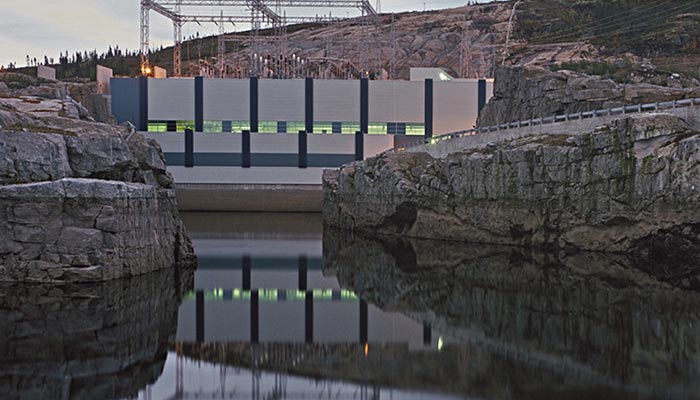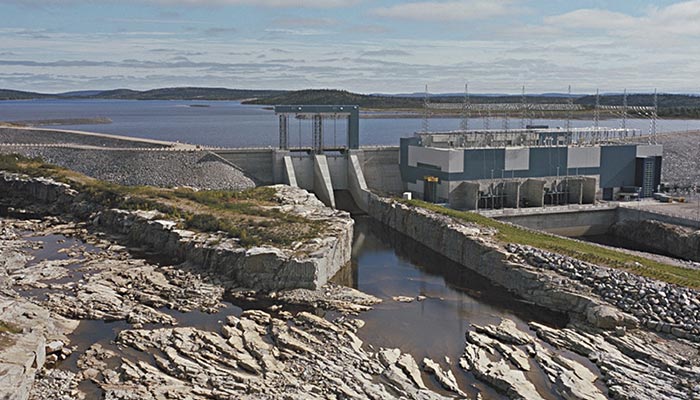1980-1996 – A Time of Uncertainty
As a result of the second oil crisis (1979), the saturation of some electricity markets and the economic recession of the early 1980s, demand for electricity dropped significantly. The ensuing climate of uncertainty made it necessary for Hydro-Québec to overhaul its development strategy, which in turn led to successive amendments to the Hydro-Québec Act. The company slashed operating expenses and launched a blitz in all its markets to dispose of the energy surpluses that were expected to arise once the La Grande — Phase I megaproject came on line. At the same time, it began to promote energy conservation. To boost customer satisfaction, Hydro-Québec instituted major programs to improve service quality and reliability. By the early 1990s, the surpluses had been absorbed and to meet growing demand, Hydro-Québec resumed work on Phase II of the La Grande complex. As the 20th century came to a close, it began development of Sainte-Marguerite-3 generating station and stepped up its promotion of energy efficiency.
1981
A broader mandate
A new law changed Hydro-Québec’s legal status and financial structure. It became a joint-stock business corporation whose sole shareholder is Québec government, to which it must pay an annual dividend. The company received a broader mandate. It could, for example, sponsor energy conservation programs, such as the Énergain program to promote more energy-efficient housing. In 1983, another amendment to the regulatory framework explicitly gave Hydro-Québec a mandate to export firm power and to pursue endeavors in any field related to energy.
Nouveler, the road to diversification
Along with three other Québec government-owned corporations involved in financing (SGF), forestry development (REXFOR) and mining exploration (SOQUEM), Hydro-Québec took part in the creation of Nouveler, an organization with a mandate to develop new forms of energy and promote energy efficiency. Nouveler became a wholly owned subsidiary of Hydro-Québec and underwent restructuring in 1997, when it was renamed Hydro-Québec CapiTech. As a venture capital company, CapiTech invests in enterprises whose products are technology-based and energy-related.
Slide show
The following slide show contains images from the year 1981
1987
Phase II of the La Grande Complex
In March, the Société d'énergie de la Baie James (SEBJ) began the second phase of the La Grande complex in the Baie-James region. The work took nine years to complete and led to the commissioning of five generating stations: La Grande-2A, Laforge-1, La Grande-1, Brisay and Laforge-2, making La Grande the most powerful hydroelectric complex in the world. La Grande was the site of many technological innovations, particularly related to construction techniques in a hostile environment. The complex contributes in large measure to Québec’s enviable supply of electricity, 97% of which is renewable and non-polluting.
Slide show
The following slide show contains images from the year 1987
In search of more efficient electrotechnologies
Hydro-Québec inaugurated its electrochemical and electrotechnologies laboratory (LTEE) in Shawinigan. The mission of this new research centre was to support the development of industrial applications for electricity, especially in mining, metallurgy, textiles, agri-food, chemicals, lumber, plastic and rubber. It provides facilities for Canadian companies to test concepts and to perfect and demonstrate electrical technologies and processes. In May 2002, its name became Laboratoire des technologies de l'énergie (LTE – Hydro-Québec's energy technologies laboratory).
Top of page1994
Sainte-Marguerite-3, Québec’s last major hydropower project of the 20th century
As in other hydroelectric developments, the dam at Sainte-Marguerite-3 has a dual function: to collect water in a reservoir and to create a head. The head at Sainte-Marguerite-3 is an exceptional 330 metres—seven times the height of Niagara Falls. At 171 metres, the dam is the highest rockfill dam in Québec.

Sainte-Marguerite-3 dam, 2009.
1996
Creation of a provincial energy board
The Québec government created the Régie de l’énergie du Québec (energy board), the agency that establishes the regulatory framework for the distribution and transmission of electric power. Any change in Québec’s electricity rates must be submitted to it for approval. In addition to setting rates, the Régie approves electricity supply plans, authorizes commercial programs and investments, and reviews customer complaints.
Top of page





